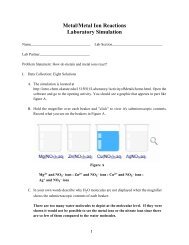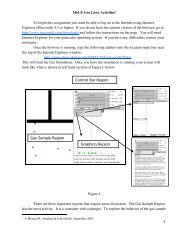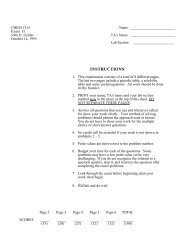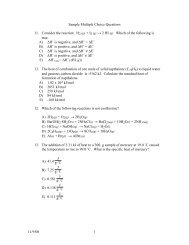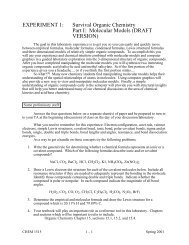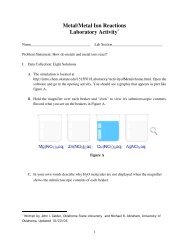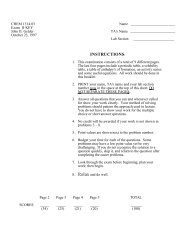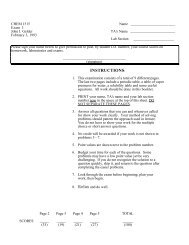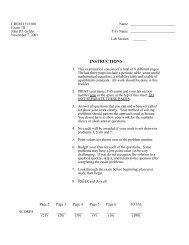Create successful ePaper yourself
Turn your PDF publications into a flip-book with our unique Google optimized e-Paper software.
CHEM 1515Exam VJohn V. GelderMay 5, 1998Name ________________________TA's Name ________________________Lab Section ________________________<strong>INSTRUCTIONS</strong>:1. This examination consists of a total of 12 different pages.The last umpteen pages include a whole heck of alot ofimportant mathematical equations, constants and tables.All work should be done in this booklet. You maycarefully remove the last 5 pages of the examination.2. PRINT your name, your TA's name and your laboratorysection now in the space at the top of this sheet. DONOT SEPARATE THE PAGES.3. Answer all questions that you can and whenever calledfor show your work clearly. Your method of solvingproblems should pattern the approach used in lecture.You do not have to show your work for the multiplechoice or short answer questions.4. No credit will be awarded if your work is not shown inproblems 8 and 9. Please circle your final answer!5. Point values are shown next to the problem number.6. Budget your time for each of the questions. Someproblems may have a low point value yet be verychallenging. If you do not recognize the solution to aquestion quickly, skip it, and return to the question aftercompleting the easier problems.7. Look through the exam before beginning; plan yourwork; then begin.<strong>8.</strong> <strong>Relax</strong> and do well.Page 2 Page 3 Page 4 Page 5 Page 6 TOTALSCORES _____ _____ _____ _____ _____ ______(21) (16) (24) (24) (15) (100)
CHEM 1515 Exam V Page 2(9) 1. Write the chemical formula(s) of the product(s) and balance the following reactions. Identify all productsphases as either (g)as, (l)iquid, (s)olid or (aq)ueous. Soluble ionic compounds should be written in theform of their component ions.a) CuSO 4 (aq) + Na 2 CO 3 (aq) →b) zinc hydroxide(s) + hydrochloric acid(aq) →c) C 5 H 5 N(aq) + H 2 SO 4 (aq) →(8) 2. Write the ionic and net ionic chemical equations for 1a) and 1b).1a)Ionic equation:Net Ionic equation:1b)Ionic equation:Net Ionic equation:(4) 3. Calculate the magnitude of the equilibrium constant for ONE of the reactions in Problem #1.
CHEM 1515 Exam V Page 3(16) 4. The reaction below proceeds spontaneously at 25 ˚C. Assume all reactants and products are in theirstandard state.2C 4 H 10 (g) + 13O 2 (g) → 8CO 2 (g) + H 2 O (l)a) Predict the sign of ∆S˚ for the reaction and justify your answer.b) What is the sign of ∆G˚ for the reaction?c) How would the sign and magnitude of ∆G˚ be affected by an increase in temperature to 50 ˚C? Explainyour answer.d) What must be the sign of ∆H˚ for the reaction at 25 ˚C?e) When the reactants are placed together in a container, no change is observed even though the reaction isknown to be spontaneous. Explain this observation.
CHEM 1515 Exam V Page 4(12) 5a. The K a for chloroacetic acid, ClCH 2 COOH, is 1.4 x 10 –3 . Identify the chemical specie(s) in an aqueoussolution of chloroacetic acid. (NOTE: you need not include water, just the specie(s) associated withchloroacetic acid.) Which is/are present in the highest concentration? Explain.b) would a solution of the conjugate base of chloroacetic acid have a pH greater than, less than orapproximately equal to 7? Explain.(6) 6. Is the pH of an aqueous solution of NaH 2 PO 4 acidic (pH < 7) or basic (pH > 7). Explain.(6) 7. Identify a metal ion capable of oxidizing Pb (s) but not Fe (s) .
CHEM 1515 Exam V Page 5(8) <strong>8.</strong> E˚ for the reaction3U 4+ (aq) + 2NO 3– (aq) + 2H2 O(l) → 3UO 22+ (aq) + 2NO(g) + 4H + (aq)is +0.63 V. Calculate the reduction cell potential for UO 22+ to U 4+ in acidic solution.(16) 9a. Cyclohexanol has a vapor pressure of 12.0 mmHg at 56.8 ˚C and a vapor pressure of 9<strong>8.</strong>0 mmHg at 102˚C. Calculate the enthalpy of vaporization, ∆H˚vap , of cyclohexanol.b) A 0.0500 gram sample of cyclohexanol is placed into an evacuated 0.500 L container at 23.0 ˚C. Thecontainer is then heated to 56.8 ˚C. Describe the phase(s) present at 56.8 ˚C. (Show your work to justifyyour answer.)
CHEM 1515 Exam V Page 6(15)10. In each of the following pairs, pick the member which has the given property. Provide a brief explanationfor our choice. Be sure explanation explains why the other choice was ruled out.a) highest boiling point; CH 3 CH 2 SH and CH 3 CH 2 OHb) lowest vapor pressure at 25 ˚C; CH 3 CH 2 CH 3 and CH 3 OCH 3c) highest boiling point; C 7 H 16 and C 10 H 22
CHEM 1515 Exam V Page 7EquationsUseful InformationConstantsln⎝ ⎜⎛ vp 2vp ⎠ ⎟⎞1= – ∆H˚vapR ⎜⎛ 1⎝T ⎠ ⎟⎞2– 1 T 1edge length (l) = 2r edge length (l) = 2 2· r edge length (l) = 4r 3PV = nRTP solution = χ solvent P˚solventR = 0.0821 L·atmmol·K = <strong>8.</strong>314density of H 2 O = 1.00 gcm 3Jmole . K∆T = ikm k f (H 2 O) = 1.86 ˚C m k b(H 2 O) = 0.512 ˚C m∆H˚rxn = ∑(∆H f˚(products)) – ∑(∆H f˚(reactants))∆S˚rxn = ∑(S˚(products)) – ∑(S˚(reactants))∆G˚rxn = ∑(∆G f˚(products)) – ∑(∆G f˚(reactants))∆G˚ = ∆H˚ - T∆S˚∆G˚ = –RT ln Kln⎝ ⎜⎛ k 1k ⎠ ⎟⎞2= E aR ⎜⎛ 1⎝T ⎠ ⎟⎞2- 1 T 1ln⎝ ⎜⎛ [A] t[A] ⎠ ⎟⎞o= -kt∆G = ∆G˚ + RT ln Q1 1[A] t- [A] o= ktK p = K c (RT) ∆nx 1,2 = –b± b2 – 4ac2a for ax 2 + bx + c = 0pH = –log[H + ] K w = 1.0 x 10 –14pH + pOH = 14
CHEM 1515 Exam V Page 81234567IA1H1.0083Li6.9411IIA4Be9.0112Na Mg22.99 24.3019 20KCa39.10 40.0837Rb Sr3885.47 87.6255 56CsBa132.9 137.387 88Fr(223)Ra226.0IIIA IVA VA VIA VIIA 4.005 6 7 8B C N O F9 10Ne10.81 12.01 14.01 16.00 19.00 20.1813 14 15 16 17 18IIIB IVB VB VIB VIIB VIII IB IIB 26.98 2<strong>8.</strong>09 30.97 32.06 35.45 39.9521 22 23 24 25 26 27 28 29Sc Ti V Cr Mn Fe Co Ni Cu 30 31 32 33 34 35 36Zn Ga Ge As Se Br Kr44.96 47.88 50.94 52.00 54.94 55.85 5<strong>8.</strong>93 5<strong>8.</strong>69 63.55 65.38 69.72 72.59 74.92 7<strong>8.</strong>96 79.90 83.8039Y Zr40 41 42 43 44 45 46 47 48 49 50 51 52 53 54Nb Mo Tc Ru Rh Pd Ag Cd In Sn Sb Te I Xe8<strong>8.</strong>91 91.22 92.91 95.94 (98) 101.1 102.9 106.4 107.9 112.4 114.8 11<strong>8.</strong>7 121.8 127.6 126.9 131.357 72 73 74 76 77 78 79 81 82 83 84 85 86LaPeriodic Table of the ElementsHfAlSiPSClVIIIA2Ta W Re 75Os Ir Pt Au Hg 80Tl Pb Bi Po At Rn13<strong>8.</strong>9 17<strong>8.</strong>5 180.9 183.8 186.2 190.2 192.2 195.1 197.0 200.6 204.4 207.2 209.0 (209) (210)89 104 105 106 107 108 109Ac227.0Rf DbSgBhHs Mt(261) (262) (263) (262) (265) (266)HeAr(222)LanthanidesActinides58 59 60 61 62 63 64Ce Pr Nd Pm Sm Eu Gd 65 66 67 68 69 70 71Tb Dy Ho Er Tm Yb Lu140.1 140.9 144.2 (145) 150.4 152.0 157.2 15<strong>8.</strong>9 162.5 164.9 167.3 16<strong>8.</strong>9 173.0 175.090 91 92 93 94 95 96Th Pa U Np Pu AmCm 97 98 99 100 101 102 103Bk Cf Es Fm Md No Lr232.0 231.0 23<strong>8.</strong>0 237.0 (244) (243) (247) (247) (251) (252) (257) (258) (259) (260)
CHEM 1515 Exam V Page 9E.1 DISSOCIATION CONSTANTS FOR ACIDS AT 25 ˚CName Formula K a1 K a2 K a3Acetic HC 2 H 3 O 2 1.8 x 10 –5Ascorbic HC 6 H 7 O 6 <strong>8.</strong>0 x 10 –3Arsenic H 3 AsO 4 5.6 x 10 –3 1.0 x 10 –7 3.0 x 10 –12Arsenous H 3 AsO 3 6.0 x 10 –10Benzoic HC 7 H 5 O 2 6.5 x 10 –5Boric H 3 BO 3 5.8 x 10 –10Butyric acid HC 4 H 7 O 2 1.5 x 10 –5Carbonic H 2 CO 3 4.3 x 10 –7 5.6 x 10 –11Cyanic HCNO 3.5 x 10 –4Citric H 3 C 6 H 5 O 7 7.4 x 10 –4 1.7 x 10 –5 4.0 x 10 –7Formic HCHO 2 1.8 x 10 –4Hydroazoic HN 3 1.9 x 10 –5Hydrocyanic HCN 4.9 x 10 –10Hydrofluoric HF 7.2 x 10 –4Hydrogen chromate ion HCrO –4 3.0 x 10 –7Hydrogen peroxide H 2 O 2 2.4 x 10 –12Hydrogen selenate ion HSeO –4 2.2 x 10 –2Hydrogen sulfate ion HSO –4 1.2 x 10 –2Hydrogen sulfide H 2 S 5.7 x 10 –8 1.3 x 10 –13Hypobromous HBrO 2.0 x 10 –9Hypochlorous HClO 3.0 x 10 –8Hypoiodus HIO 2.0 x 10 –11Iodic HIO 3 1.7 x 10 –1Lactic HC 3 H 5 O 3 1.4 x 10 –4Malonic H 2 C 3 H 2 O 4 1.5 x 10 –3 2.0 x 10 –6Oxalic H 2 C 2 O 4 5.9 x 10 –2 6.4 x 10 –5Nitrous HNO 2 4.5 x 10 –4Phenol HC 6 H 5 O 1.3 x 10 –10Phosphoric H 3 PO 4 7.5 x 10 –3 6.2 x 10 –8 4.2 x 10 –13Paraperiodic H 5 IO 6 2.8 x 10 –2 5.3 x 10 –9Propanoic HC 3 H 5 O 2 1.4 x 10 –5Pyrophosphoric H 4 P 2 O 3.0 x 10 –2 4.4 x 10 –3Selenous H 2 SeO 3 2.3 x 10 –3 5.3 x 10 –9Sulfuric H 2 SO 4 strong acid 1.2 x 10 –2Sulfurous H 2 SO 3 1.7 x 10 –2 6.4 x 10 –8Tartaric H 2 C 4 H 4 O 6 1.0 x 10 –3 4.6 x 10 –5E.2 DISSOCIATION CONSTANTS FOR BASES AT 25˚CName Formula K b Name Formula K bAmmonia NH 3 1.8 x 10 –5 Hydroxylamine HONH 2 1.1 x 10 –8Aniline C 6 H 5 NH 2 4.3 x 10 –10 Methylamine CH 3 NH 2 4.4 x 10 –4Dimethylamine (CH 3 ) 2 NH 5.4 x 10 –4 Pyridine C 5 H 5 N 1.7 x 10 –9Ethylamine C 2 H 5 NH 2 6.4 x 10 –4 Trimethylamine (CH 3 ) 3 N 6.4 x 10 –5Hydrazine H 2 NNH 2 1.3 x 10 –6
CHEM 1515 Exam V Page 10E. 3 SOLUBILITY-PRODUCT CONSTANTS FOR COMPOUNDS AT 25˚CName Formula K spBarium carbonate BaCO 3 5.1 x 10 -9Barium chromate BaCrO 4 1.2 x 10 -10Barium Fluoride BaF 2 1.0 x 10 -6Barium hydroxide Ba(OH) 2 5 x 10 -3Barium oxalate BaC 2 O 4 1.6 x 10 -7Barium phosphate Ba 3 (PO 4 ) 2 3.4 x 10 -23Barium sulfate BaSO 4 1.1 x 10 -10Cadmium carbonate CdCO 3 5.2 x 10 -12Cadmium sulfide CdS <strong>8.</strong>0 x 10 -27Calcium carbonate CaCO 3 2.8 x 10 -9Calcium chromate CaCrO 4 7.1 x 10 -4Calcium fluoride CaF 2 3.9 x 10 -11Calcium hydroxide Ca(OH) 2 5.5 x 10 -6Calcium phosphate Ca 3 (PO 4 ) 2 2.0 x 10 -29Calcium sulfate CaSO 4 9.1 x 10 -6Cerium(III) fluoride CeF 3 8 x 10 -16Chromium(III) fluoride CrF 3 6.6 x 10 -11Chromium(III) hydroxide Cr(OH) 3 6.3 x 10 -31Cobalt(II) carbonate CoCO 3 1.4 x 10 -13Cobalt(II) hydroxide Co(OH) 2 1.6 x 10 -15Cobalt(III) hydroxide Co(OH) 3 1.6 x 10 -44Copper(I) bromide CuBr 5.3 x 10 -9Copper(I) chloride CuCl 1.2 x 10 -6Copper(I) sulfide Cu 2 S 2.5 x 10 -48Copper(II) carbonate CuCO 3 1.4 x 10 -10Copper(II) chromate CuCrO 4 3.6 x 10 -6Copper(II) hydroxide Cu(OH) 2 2.2 x 10 -20Copper(II) phosphate Cu 3 (PO 4 ) 2 1.3 x 10 - 37Copper(II) sulfide CuS 6.3 x 10 -36Gold(III) chloride AuCl 3 3.2 x 10 -25Iron(II) carbonate FeCO 3 3.2 x 10 -11Iron(II) hydroxide Fe(OH) 2 <strong>8.</strong>0 x 10 -16Iron(II) sulfide FeS 6.3 x 10 -18Iron(III) hydroxide Fe(OH) 3 4 x 10 -38Lanthanum fluoride LaF 3 7 x 10 -17Lanthanum iodate La(IO 3 ) 3 6.1 x 10 -12Lead carbonate PbCO 3 7.4 x 10 -14Lead chloride PbCl 2 1.6 x 10 -5Lead chromate PbCrO 4 2.8 x 10 -13Lead fluoride PbF 2 2.7 x 10 -8Lead hydroxide Pb(OH) 2 1.2 x 10 -15Lead iodide PbI 2 7.1 x 10 -9Lead sulfide PbS <strong>8.</strong>0 x 10 -28Magnesium hydroxide Mg(OH) 2 1.8 x 10 -11Magnesium oxalate MgC 2 O 4 <strong>8.</strong>6 x 10 -5Manganese carbonate MnCO 3 1.8 x 10 -11Mercury(I) sulfide Hg 2 S 1.0 x 10 -47Mercury(II) sulfide HgS 4.0 x 10 -53Silver chloride AgCl 1.8 x 10 -10Silver chromate Ag 2 CrO 4 1.1 x 10 -12Silver sulfide Ag 2 S 6.3 x 10 -50Strontium fluoride SrF 2 2.5 x 10 -9
CHEM 1515 Exam V Page 11A. Acidic Solution E o (V)Li + + e – → Li(s) –3.045K + + e – → K(s) –2.925Ba 2+ + 2e – → Ba(s) –2.906Sr 2+ + 2e – → Sr(s) –2.888Ca 2+ + 2e – → Ca(s) –2.866Na + + e – → Na(s) –2.714Mg 2+ + 2e – → Mg(s) –2.363Al 3+ + 3e – → Al(s) –1.662Mn 2+ + 2e – → Mn(s) –1.185Zn 2+ + 2e – → Zn(s) –0.763Cr 3+ + 3e – → Cr(s) –0.744Fe 2+ + 2e – → Fe(s) –0.440Cr 3+ + e – → Cr 2+ –0.408Cd 2+ + 2e – → Cd(s) –0.403PbSO 4 (s) + 2e – → Pb(s) + SO 2– 4 –0.359PbCl 2 (s) + 2e – → Pb(s) + 2Cl – –0.268Ni 2+ + 2e – → Ni(s) –0.250Sn 2+ + 2e – → Sn(s) –0.136Pb 2+ + 2e – → Pb(s) –0.1262H + + 2e – → H 2 (g) 0.000S(s) + 2H + + 2e – → H 2 S(aq) 0.142Sn 4+ + 2e – → Sn 2+ 0.15Sb 2 O 3 (s) + 6H + + 6e – → 2Sb(s) + 3H 2 O(l) 0.152Cu 2+ + e – → Cu + 0.153SO 2– 4 + 4H + + 2e – → H 2 SO 3 (aq) + H 2 O(l) 0.172AgCl(s) + e – → Ag(s) + Cl – 0.222Cu 2+ + 2e – → Cu(s) 0.337SO 2– 4 + 8H + + 6e – → S(s) + 4H 2 O(l) 0.357H 2 SO 3 (aq) + 4H + + 4e – → S(s) + 3H 2 O(l) 0.450I 2 (s) + 2e – → 2I – 0.536MnO – 4 + e – → MnO 2– 4 0.564O 2 (g) + 2H + + 2e – → H 2 O 2 (aq) 0.682Fe 3+ + e – → Fe 2+ 0.771Hg 2+ + 2e – → Hg(l) 0.788Ag + + e – → Ag(s) 0.7992NO – 3 + 4H + + 2e – → N 2 O 4 (g) + 2H 2 O(l) 0.8032Hg 2+ + 2e – → Hg 2+ 2 0.920NO – 3 + 4H + + 3e – → NO(g) + 2H 2 O(l) 0.96Pd 2+ + 2e – → Pd(s) 0.987Br 2 (l) + 2e – → 2Br – 1.065Br 2 (aq) + 2e – → 2Br – 1.087ClO – 4 + 2H + + 2e – → ClO – 3 + H 2 O(l) 1.192IO – 3 + 12H + + 10e – → I 2 (s) + 6H 2 O(l) 1.195Table of Standard Reduction Potentials (25 ˚C)Pt 2+ + 2e – → Pt(s) ~1.2ClO – 3 + 3H + + 2e – → HClO 2 (aq) + H 2 O(l) 1.21O 2 (g) + 4H + + 4e – → 2H 2 O(l) 1.229O 2 (g) + 4H + (pH = 7) + 4e – → 2H 2 O(l) 0.83MnO 2 (s) + 4H + + 2e – → Mn 2+ + 2H 2 O(l) 1.232HNO 2 (aq) + 4H + + 4e – → N 2 O(g) + 3H 2 O(l) 1.29Cr 2 O 2– 7 + 14H + + 6e – → 2Cr 3+ + 7H 2 O(l) 1.33Cl 2 (g) + 2e – → 2Cl – 1.360PbO 2 (s) + 4H + + 2e – → Pb 2+ + 2H 2 O(l) 1.455Au 3+ + 3e – → Au(s) 1.498MnO – 4 + 8H + + 5e – → Mn 2+ + 4H 2 O(l) 1.512HClO(aq) + 2H + + 2e – → Cl 2 (g) + 2H 2 O(l) 1.63H 2 O 2 (aq) + 2H + + 2e – → 2H 2 O(l) 1.776S 2 O 2– 8 + 2e – → 2SO 2– 4 2.00O 3 (g) + 2H + + 2e – → O 2 (g) + H 2 O(l) 2.07F 2 (g) + 2e – → 2F – 2.87F 2 (g) + 2H + + 2e – → 2HF(aq) 3.06B. Alkaline Solution E o (V)Mg(OH) 2 (s) + 2e – → Mg(s) + 2OH – –2.690Al(OH) 3 (s) + 3e – → Al(s) + 3OH – –2.30Zn(OH) 2 (s) + 2e – → Zn(s) + 2OH – –1.245Fe(OH) 2 (s) + 2e – → Fe(s) + 2OH – –0.8772H 2 O(l) + 2e – → H 2 (g) + 2OH – –0.8282H 2 O(l) + 2e – → H 2 (g) + 2OH – (pH = 7) –0.43Cd(OH) 2 (s) + 2e – → Cd(s) + 2OH – –0.809Ni(OH) 2 (s) + 2e – → Ni(s) + 2OH – –0.72Fe(OH) 3 (s) + e – → Fe(OH) 2 (s) + OH – –0.562S(s) + 2e – → S 2- 2 –0.447Cu 2 O(s) + H 2 O(l) + 2e – → 2Cu(s) + 2OH – –0.358CrO 2– 4 + 4H 2 O(l) + 3e – → Cr(OH) 3 (s) + 5OH – –0.13MnO 2 (s) + 2H 2 O(l) + 2e – → Mn(OH) 2 (s) + 2OH – –0.05NO – 3 + H 2 O(l) + 2e – → NO – 2 + 2OH – 0.01PbO 2 (s) + H 2 O(l) + 2e – → PbO(s) + 2OH – 0.247ClO – 3 + H 2 O(l) + 2e – → ClO – 2 + 2OH – 0.33ClO – 4 + H 2 O(l) + 2e – → ClO – 3 + 2OH – 0.36O 2 (g) + 2H 2 O(l) + 4e – → 4OH – 0.401NiO 2 (s) + 2H 2 O(l) + 2e – → Ni(OH) 2 (s) + 2OH – 0.490MnO – 4 + 2H 2 O(l) + 3e – → MnO 2 (s) + 4OH – 0.588BrO – 3 + 3H 2 O(l) + 6e – → Br – + 6OH – 0.61ClO – + H 2 O(l) + 2e – → Cl – + 2OH – 0.89O 3 (g) + H 2 O(l) + 2e – → O 2 (g) + 2OH – 1.24
CHEM 1515 Exam V Page 12Substance ∆H o f∆G o fS oand State ⎝ ⎛ ⎠ ⎞ JK . molCarbonC(s) (graphite) 0 0 6C(s) (diamond) 2 3 2CO(g) -110.5 -137 198CO2(g) -393.5 -394 214CH4(g) ? -51 186CH3OH(g) -201 -163 240CH3OH(l) -239 -166 127H2CO(g) -116 -110 219HCOOH(g) -363 -351 249HCN(g) 135.1 125 202C2H2(g) 227 209 201C2H4(g) 52 68 219CH3CHO(g) -166 -129 250C2H5OH(l) -278 -175 161C2H6(g) -84.7 -32.9 229.5C3H6(g) 20.9 62.7 266.9C3H8(g) -104 -24 270mol⎝ ⎛ ⎠ ⎞mol ⎝ ⎛ ⎠ ⎞Thermodynamic Values (25 ˚C)Substance ∆H o fand State ⎝ ⎛ kJ ⎠ ⎞∆G o fkJS oJK . molmol⎝ ⎛ ⎠ ⎞mol ⎝ ⎛ ⎠ ⎞NitrogenN2(g) 0 0 192NCl3(g) 230 271 -137NF3(g) -125 -83.6 -139NH3(g) -46.2 -17 193NH3(aq) -80.3 -27 111N2H4(g) 95.4 159.3 238NO(g) 90 87 211NO2(g) 32 52 240N2O(g) 82 104 220N2O4(g) 10 98 304N2O5(g) -42 134 178N2H3CH3(l) 54 180 166HNO3(aq) -207 -111 146HNO3(l) -174 -81 156NH4Cl(s) -314 -201 95NH4ClO4(s) -295 -89 186BromineBr2(l) 0 0 152.BrCl(g) 14.64 -0.96 240ChlorineCl2(g) 0 0 223Cl2(aq) -23 7 121Cl - (aq) -167 -131 57HCl(g) -92 -95 187FluorineF 2 (g) 0 0 203F - (aq) -333 -279 -14HF(g) -271 -273 174HydrogenH2(g) 0 0 131H(g)217 203 115H + (aq) 0 0 0OH - (aq) -230 -157 -11H2O(l) -286 -237 70H2O(g) -242 -229 189MagnesiumMg(s) 0 0 33Mg(aq) -492 -456 -118MgO(s) -601 -569 26.9OxygenO2(g) 0 0 205O(g)249 232 161O3(g) 143 163 239SilverAg(s) 0 0 42.6Ag + (aq) 105.6 77.1 72.7Ag(S2O3) 3- (aq) -1285.7 -- --AgBr(s) -100.4 -96.9 107.1AgCl(s) -127.1 -109.8 96.2SulfurS(rhombic) 0 0 31.8SO 2 (g) -296.8 -300.2 24<strong>8.</strong>8SO 3 (g) -395.7 -371.1 256.3H 2 S(g) -20.17 -33.0 205.6TitaniumTiCl4(g) -763 -727 355TiO2(s) -945 -890 50AluminumAlCl3(s) -526 -505 184BariumBaCl2(aq) -872 -823 123Ba(OH)2·8H2O(s) -3342 -2793 427IodineI2(s) 0 0 116.7HI(g) 25.94 1.30 206.3



